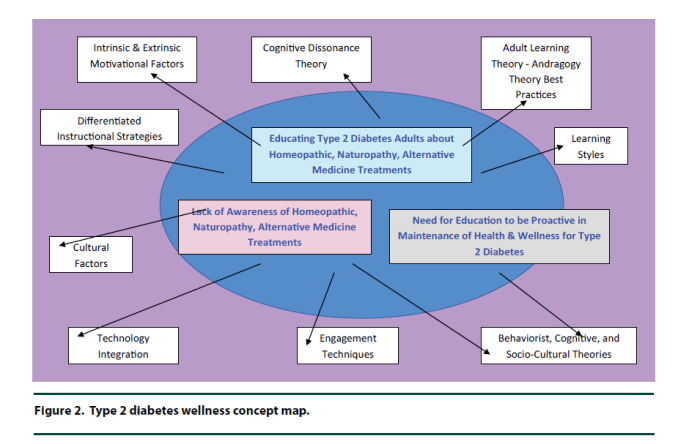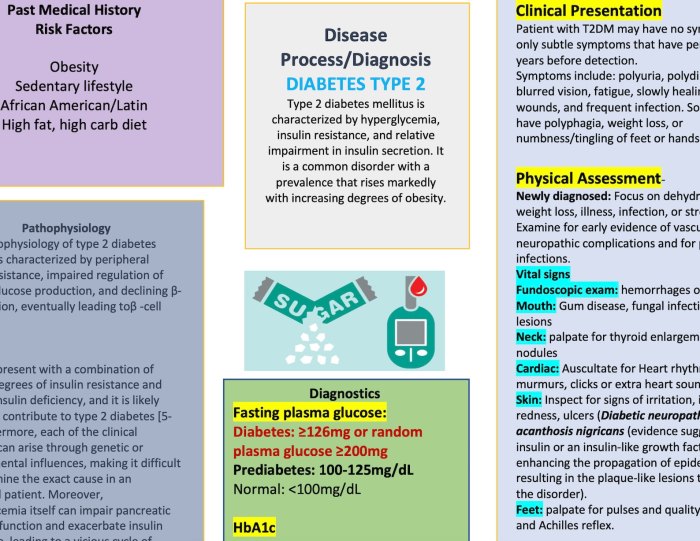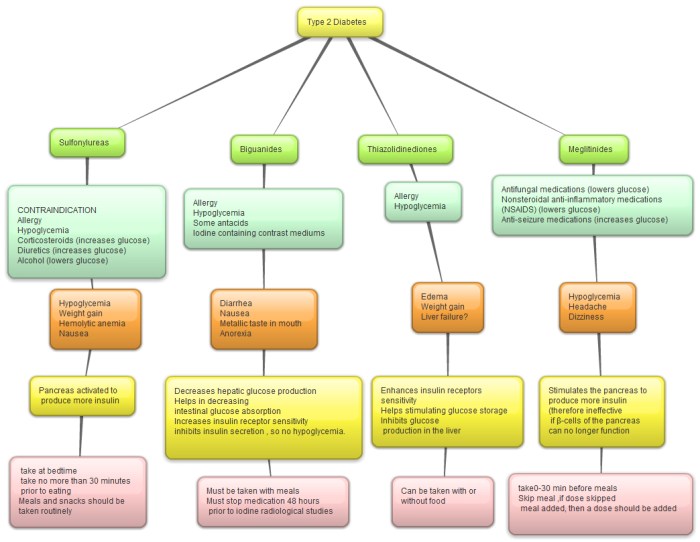The concept map for diabetes type 2 unfolds as a captivating tapestry, inviting readers to embark on a journey through the intricacies of this prevalent condition. This visual representation unravels the complex relationships between concepts, providing a comprehensive understanding that resonates with both clarity and depth.
As we delve deeper into the elements that constitute a concept map for diabetes type 2, we discover the building blocks that form the foundation of this powerful tool. Concepts, relationships, and linking words dance together in a harmonious interplay, conveying the structure and meaning of the map with remarkable precision.
Definition of a Concept Map for Diabetes Type 2

A concept map for diabetes type 2 is a graphical representation of the complex relationships between concepts and ideas related to this condition. It visually organizes and connects key concepts, terms, and phrases to help individuals understand the nature, causes, symptoms, and management of diabetes type 2.
Concept maps are effective tools for organizing and understanding complex information. They help individuals identify the main concepts, their relationships, and how they contribute to the overall understanding of diabetes type 2.
Elements of a Concept Map for Diabetes Type 2
A concept map for diabetes type 2 is a visual representation of the relationships between different concepts related to the condition. It helps to organize and structure information, making it easier to understand and remember. The key elements of a concept map include concepts, relationships, and linking words.
Concepts
Concepts are the main ideas or topics that are being mapped. In a concept map for diabetes type 2, concepts might include things like “insulin resistance,” “hyperglycemia,” and “lifestyle factors.” Concepts should be represented as boxes or circles, and they should be labeled with clear and concise terms.
Relationships
Relationships show the connections between different concepts. In a concept map for diabetes type 2, relationships might include things like “causes,” “contributes to,” or “is a symptom of.” Relationships are represented by lines or arrows, and they should be labeled with appropriate linking words.
Linking Words
Linking words are used to connect concepts and relationships. They help to clarify the meaning of the map and make it easier to read. Some common linking words used in concept maps include “because,” “so,” and “therefore.” Linking words should be placed between concepts and relationships, and they should be chosen carefully to accurately reflect the meaning of the connection.
Benefits of Using a Concept Map for Diabetes Type 2

Utilizing concept maps to understand diabetes type 2 offers numerous advantages. These include enhanced comprehension, better knowledge retention, and improved critical thinking skills.
Concept maps present information in a visual and structured manner, making it easier for individuals to grasp complex concepts. The interconnected nodes and links facilitate a deeper understanding of the relationships between different aspects of diabetes type 2.
Educational Settings
In educational settings, concept maps can be employed to:
- Provide a visual representation of the course material, helping students comprehend and retain information more effectively.
- Facilitate group discussions and collaborative learning, as students can share and compare their concept maps.
- Assess students’ understanding of the subject matter by having them create their own concept maps.
Clinical Settings
In clinical settings, concept maps can be used to:
- Enhance patient education by providing a personalized and interactive way to explain the disease and its management.
- Facilitate communication between healthcare professionals and patients, ensuring a shared understanding of the patient’s condition.
- Support decision-making by visualizing the potential consequences of different treatment options.
Creating a Concept Map for Diabetes Type 2

Crafting a concept map for diabetes type 2 can be an effective way to organize and understand the complex relationships between concepts related to the condition. Here’s a step-by-step guide to help you create one:Identifying Concepts:Start by identifying the key concepts associated with diabetes type 2. This includes terms like insulin resistance, hyperglycemia, and lifestyle factors.
Creating a concept map for diabetes type 2 can help you understand the complex interactions between different factors that contribute to the condition. Just like the diversity of species described in the origin of species mbti , the factors influencing diabetes type 2 are interconnected and understanding these relationships can empower you to make informed decisions about your health.
Brainstorm a list of these concepts and write them down.Establishing Relationships:Once you have your list of concepts, determine how they are related to each other. Draw lines or arrows to connect related concepts. For example, you might connect “insulin resistance” to “hyperglycemia” with an arrow labeled “leads to.”Linking
with Words:Use appropriate words or phrases to describe the relationships between concepts. These words or phrases should clarify the nature of the connection. For example, you might use the phrase “contributes to” to link “lifestyle factors” to “insulin resistance.”Organizing and Presenting:Organize your concept map in a way that makes sense to you.
You can use different colors, shapes, or sizes to represent different categories of concepts. Consider using a computer software program or online tool to create a visually appealing and easy-to-understand map.Tips for Organizing and Presenting:
- Use a clear and concise layout.
- Group related concepts together.
- Use colors and shapes to differentiate concepts.
- Add annotations or notes to provide additional information.
- Consider using a software program or online tool to create a visually appealing map.
Examples of Concept Maps for Diabetes Type 2
Concept maps for diabetes type 2 provide a visual representation of the complex relationships between various aspects of the condition. These maps can be used to enhance understanding, facilitate communication, and support decision-making.Real-world examples of concept maps for diabetes type 2 cover a wide range of topics, including:
Risk Factors
- Obesity and overweight
- Physical inactivity
- Unhealthy diet
- Family history of diabetes
- Certain ethnicities
- Gestational diabetes
- Polycystic ovary syndrome (PCOS)
- Certain medications
Symptoms, Concept map for diabetes type 2
- Increased thirst
- Frequent urination
- Unexplained weight loss
- Increased hunger
- Fatigue
- Blurred vision
- Slow-healing sores
- Frequent infections
Treatment Options
- Lifestyle changes (diet, exercise, weight loss)
- Medications (oral medications, insulin)
- Surgery (rarely)
- Monitoring and management of blood sugar levels
- Patient education and support
The structure and content of these maps vary depending on their purpose and intended audience. Some maps may focus on a specific aspect of diabetes type 2, such as risk factors or treatment options, while others may provide a more comprehensive overview of the condition.Strengths
of concept maps for diabetes type 2 include their ability to:
- Visually represent complex relationships
- Enhance understanding and recall
- Facilitate communication between healthcare providers and patients
- Support decision-making and self-management
Areas for improvement may include:
- Ensuring the accuracy and currency of information
- Making maps accessible to individuals with different learning styles and literacy levels
- Integrating interactive elements to enhance engagement
Overall, concept maps for diabetes type 2 can be valuable tools for healthcare providers, patients, and educators. They provide a structured and visual way to understand, communicate, and manage this complex condition.
Limitations of Concept Maps for Diabetes Type 2

While concept maps can be a valuable tool for understanding and managing diabetes type 2, they do have some limitations. One limitation is that they can be difficult to create, especially for people who are new to the condition. Another limitation is that they may not be able to capture the full complexity of diabetes type 2, which is a complex and multifaceted condition.
Additionally, concept maps may not be able to represent all of the relevant information about diabetes type 2. For example, they may not be able to capture the emotional and social aspects of the condition, or the impact that it can have on a person’s quality of life.
Alternative Methods or Tools
There are a number of alternative methods or tools that can be used to complement concept maps for diabetes type 2. These include:
- Diabetes management apps:These apps can help people with diabetes track their blood sugar levels, medication, and diet. They can also provide educational resources and support.
- Online support groups:These groups can provide people with diabetes with a safe and supportive environment to share their experiences and learn from others.
- Diabetes educators:These healthcare professionals can provide people with diabetes with education and support on how to manage their condition.
Query Resolution
What is the purpose of a concept map for diabetes type 2?
A concept map for diabetes type 2 provides a visual representation of the complex relationships between concepts related to the condition, aiding in comprehension, knowledge retention, and critical thinking.
How can concept maps be used in educational settings?
Concept maps can be employed as teaching aids to illustrate the interconnectedness of concepts, facilitate group discussions, and assess student understanding.
What are the limitations of concept maps for diabetes type 2?
While concept maps offer a valuable tool for understanding diabetes type 2, they may not fully capture the complexity of the condition or represent all relevant information.